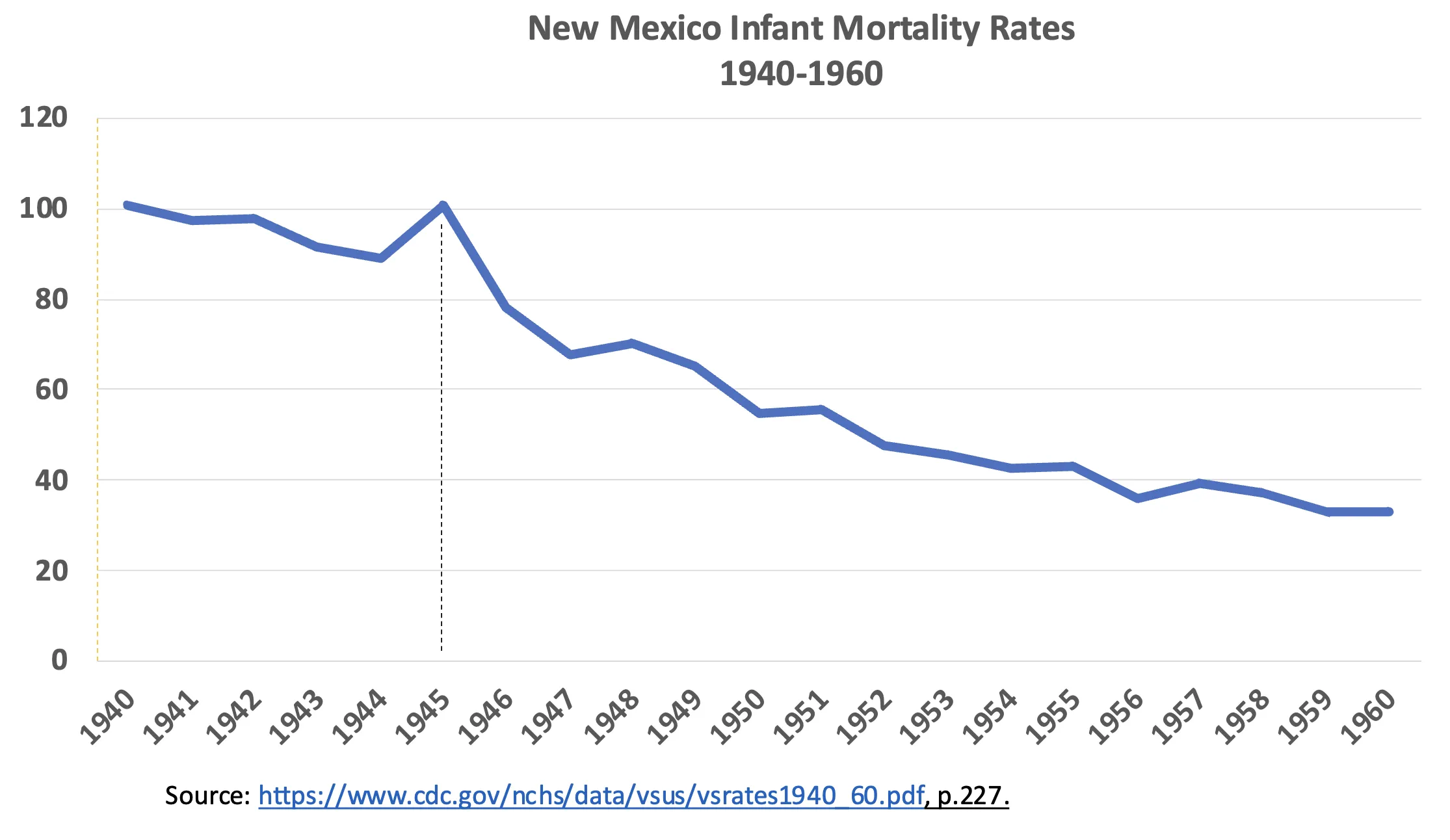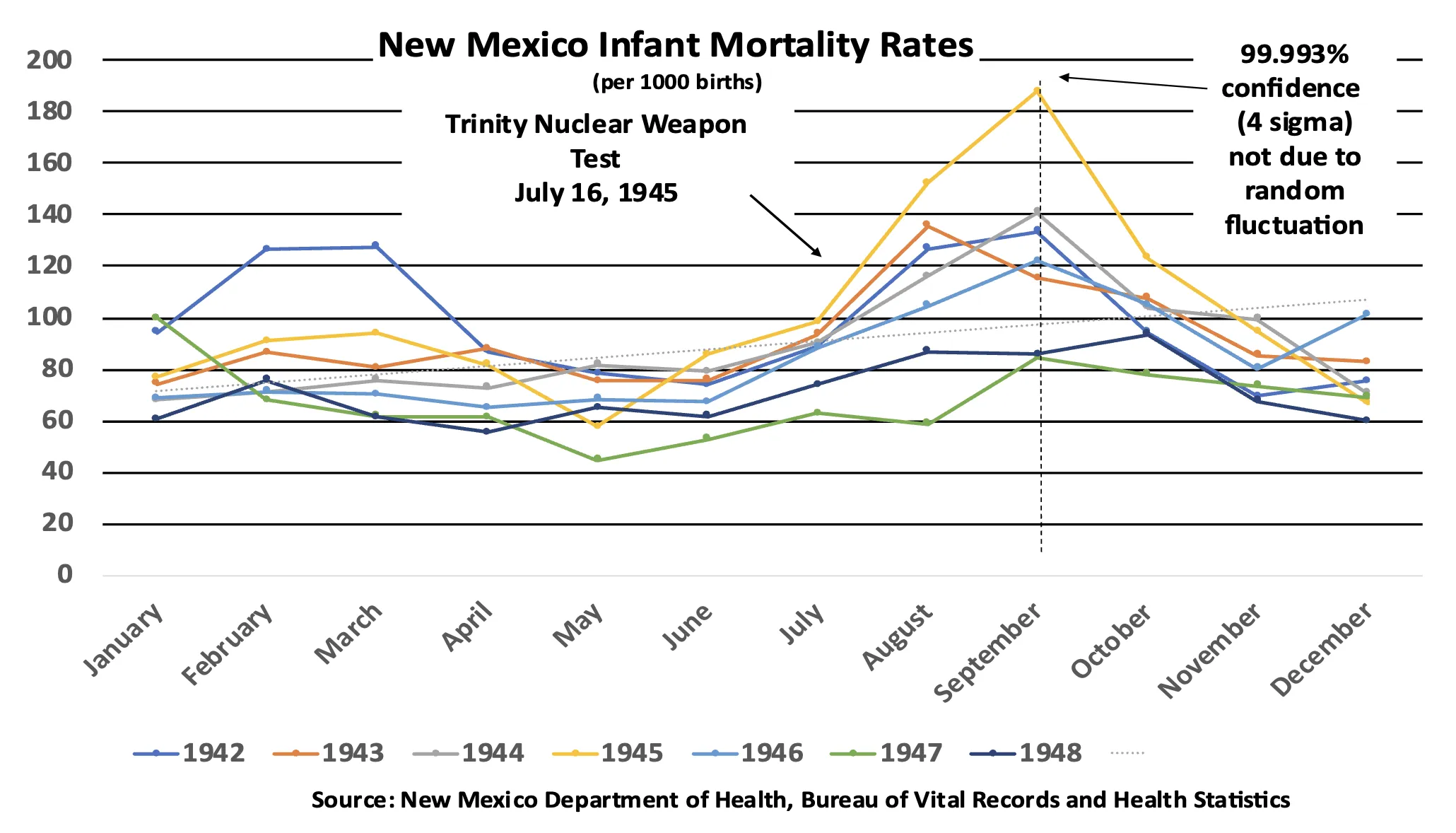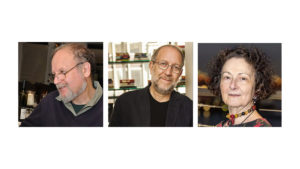BY ROBERT ALVAREZ
For decades, the assertion that “we were lucky” in the radiological aftermath of the world’s first nuclear explosion on July 16, 1945, named Trinity, has taken on a folklore status. “The only reason the Trinity test did not irradiate 100,000 people was because of a shift in the wind,” Jack Detsch and Ausha Rathl recently wrote in Foreign Policy magazine. “One wrong gust, and radioactive dust would have blanketed Albuquerque and Santa Fe.”[1] Even if true, this anecdote misses the more important point: The radiological consequences from the world’s first nuclear weapon explosion were large and knowledge of their extent continues to unfold.
Scientists—including Oppenheimer—recognized the hazards of radioactive fallout several years before the Trinity test. “Owing to the spread of radioactive substances with the wind, the bomb could probably not be used without killing large numbers of civilians, and this may make it unsuitable as a weapon for use by this country,” physicists Otto Frisch and Rudolf Peierls warned in their important memorandum of March 1940.[2]
In their statement opposing deployment of the H-Bomb in October 1949, Oppenheimer and fellow members of the Atomic Energy Commission’s (AEC) General Advisory Committee made clear that the existential threat posed by radioactive fallout was definitely on their minds. “We are alarmed as to the possible global effects of the radioactivity generated by the explosion of a few super bombs of conceivable magnitude.”[3] Oppenheimer and his colleagues were stating a scientific consensus reached at the Los Alamos Laboratory by 1945 [4] Soon after President Truman overruled Oppenheimer and his colleagues, Albert Einstein warned the public in more direct terms, stating that “radioactive poisoning of the atmosphere and hence annihilation of any life on Earth has been brought into the realm of technical possibilities.”[5]
By the time that Oppenheimer was banished from government service in 1954, the nuclear weapons program had a secret human experiment underway involving the surreptitious collection of human tissues from across the globe, so as to determine how many open-air nuclear explosions could render the Earth uninhabitable.[6] Since then, atmospheric nuclear weapons tests conducted between 1945 and 1963 have resulted in “ by far the greatest exposure of mankind to ionizing radiation.”[7]
Seventy-four years after Trinity, my wife and I published evidence indicating that the first victims of the first nuclear explosion might have been America’s children.[8] Based on New Mexico’s health data, we discovered an unusual excess of infant deaths following the Trinity detonation. From 1940 through 1960, infant mortality rates in New Mexico dramatically declined each year—except for 1945, when the death rate significantly exceeded all other years (Figure 1).
Infant death rates were especially elevated during the three months after the Trinity detonation, when the largest doses from external radiation and iodine 131 are estimated to have occurred.[9] The risk of children dying throughout New Mexico increased by 56 percent during the first three months after the explosion. The chance that this increased risk was due to a random fluctuation is 0.0007 percent. (See Figure 2.)


Iodine 131 exposures to children: Exposures from inhalation and ingestion of water and food contaminated by Trinity test fallout were never assessed—until October of 2020, when the National Cancer Institute published its fallout dose reconstruction study.[10] Of particular concern are exposures to pregnant mothers, infants, and small children to iodine 131. With a half-life of 8.02 days, iodine 131 is responsible for about 80 percent of the internal organ dose from nuclear weapons fallout[11] and is among the most hazardous isotopes, because it rapidly concentrates in vegetation and especially milk products. Since it is absorbed mostly in the body’s thyroid gland, radioactive iodine has been linked to thyroid cancer and other types of thyroid disease.
Vulnerability of children to I-131 has been well established for decades. “The reason that radioiodine is so dangerous in children is that their normal growth and development, especially of the brain, depends on the thyroid gland,” says Alan H. Lockwood, professor of neurology and nuclear medicine at the University of Buffalo School of Medicine and Biomedical Sciences.[12]
There are large uncertainties in the dose estimates of the NCI’s study, which are based on retrospective estimation of consumption rates and assumptions about the contamination of the ingested food 70 years after the fact. Essential elements that are missing or obscured in the NCI study of the Trinity test were given prominence in the institute’s 1997 study of fallout from the Nevada Test Site.[13] Among the most significant are the implications of Trinity fallout doses for pregnant mothers, infants and small children.
Data buried in the appendix of the cancer institute’s Trinity study indicate that several thousand infants and small children in 26 out of 33 of New Mexico’s counties, especially the major cities, absorbed average thyroid doses in excess of long-standing federal guidance[14] protecting infants from environmental exposure to radioactive iodine (100 millirems).[15]
Children in nine counties, including in the cities of Albuquerque and Santa Fe, are estimated to have received thyroid doses above 1,000 millirems[16]—a dose for which the World Health Organization recommends the prompt use of potassium iodine to block the uptake of radioactive iodine. Five counties, including the city of Albuquerque, received thyroid doses that are close to or greater than those linked to a significant risk of childhood thyroid cancers among children exposed to fallout from the Chernobyl accident (approximately 5,000 millirems).[17] Even though these protective measures are “guardrails” based on scientific evidence of harmful effects, they are absent in the NCI’s discussion of risk in the context for the most vulnerable.
A 2002 study by the Agency for Toxic Substances Disease Registry of mothers and children exposed to releases of iodine 131 at the Hanford nuclear production complex in Washington state, reported a significant exposure-related risk of pre-term birth problems as well as a suggestion of infant deaths linked to the Hanford releases.[18]
The statistical correlation of excess infants deaths with the Trinity blast raises a critical question as to where the burden of proof should lie in terms of compensating those affected, especially given the mendacious conduct by the US nuclear weapons program. The record is extensive and clear that in order to prosecute the nuclear arms race, the US government willfully deceived the public about the nature and extent of harm that could be caused by radioactive fallout.
We discovered correspondence showing that medical experts with the Manhattan Project engaged in deception and misrepresentation of health data when confronted with concerns by a local health care provider over an unusual number of infant deaths in Roswell, New Mexico shortly after the Trinity blast. After claiming to have reviewed New Mexico’s unpublished data (when they actually didn’t possess it), the Manhattan Project medical experts declared that nothing untoward had occurred. However, the unpublished hand-written data which was finally provided to the Los Alamos health experts in 1948 revealed that the infant death rate was 38 percent higher in 1945 than in 1946 and was 57 percent higher than in 1947. [19]
***
Warning the public about the manifestly dangerous Trinity experiment took a back seat to producing the first atomic bombs. In the end, the scientific director of the Los Alamos lab where the atomic bombs were created, J. Robert Oppenheimer, deferred to the military when it came to public safety and key policy decisions about use of the bombs. Alvin Weinberg, director of Oak Ridge Laboratory during and after the Manhattan Project, captured the mindset, explaining that it was shared by leaders who believed that “all else including safety, was secondary.”[20]
After being informed a month before the test by physicist Joseph Hirschfelder that radioactive fallout from the Trinity test might be a larger problem than assumed, Oppenheimer kicked the problem up to the overall director of the Manhattan Project, Gen. Leslie Groves. To avoid potential legal liabilities, Groves reluctantly agreed to dispatch a team to track the deposition of radioactive material from the bomb cloud. That effort turned out to be too little, too late.
The 24.8 kiloton Trinity explosion occurred on a tower 100 feet above the ground and has been likened to a “dirty bomb,” casting large amounts of heavily contaminated soil and debris that contained 80 percent of the bomb’s unfissioned plutonium over 46 states, and Canada.[21]
Five days after the explosion, Stafford Warren, head of radiation safety for the test, reported to Groves that “a very serious hazard” existed over a 2,700-square-mile area downwind from the test—an area 70 times greater than the 38.5 square miles predicted by Los Alamos scientists before the explosion. In 2010, the US Centers for Disease Control and Prevention underscored Warren’s assessment by concluding that “exposure rates in public areas from the world’s first nuclear explosion were measured at levels 10,000 times higher than currently allowed.”[22]
In a matter of weeks, Oppenheimer and Groves were made aware by the Eastman-Kodak company that fallout containing radioactive particles from the Trinity detonation had fogged its X-ray film stock via contaminated cardboard packages. River water and straw used in making the cardboard had been radioactively contaminated at high levels—1,254 miles away from the test, at a facility near Vincennes, Indiana.[23] The government took prompt action to warn Eastman-Kodak, a prime Manhattan Project contractor, about pending future bomb tests.
Meanwhile, after 75 years, justice is long overdue for thousands of down-winders who were never warned about the poisonous radioactive clouds created by the first nuclear bomb explosion.




